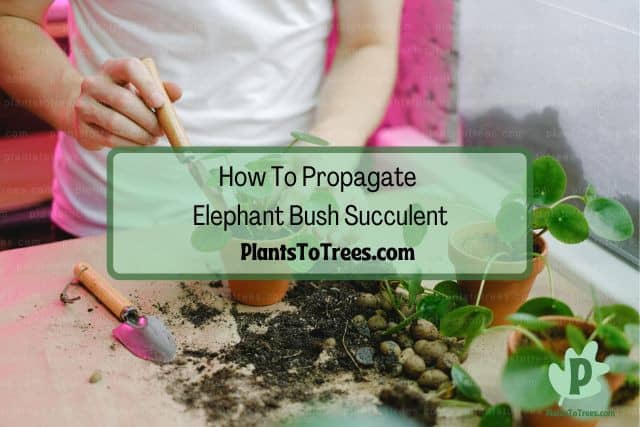If you’re looking for an easy-going plant that doesn’t require a lot of fussing over but can still improve the overall appearance of the room, then look no further than the elephant bush succulent. This plant features vibrant green leaves on reddish stems and, because it is a succulent, doesn’t need a whole lot of watering.

Elephant bush succulent care guide helps to ensure you give this plant the right care it needs to thrive in your home. This includes providing it with indirect light, warm temperatures, the proper amount of watering, and keeping an eye on potential diseases.
Other Names Of Elephant Bush Succulent
Almost all plants go by more than one name. And while elephant bush may be the most common, it’s not the only name that this succulent is known by.
Elephant bush succulent goes by a number of different names, including porkbush and dwarf jade plant. Even though it is sometimes called dwarf jade plant, the elephant bush succulent isn’t related to the true jade plant.
This succulent is native to South Africa and features small, green leaves and reddish stems. With that said, however, the actual color and size of the leaves and stems can vary depending on the cultivar.
Frost Tolerance And USDA Hardiness Zones Of Elephant Bush Succulent

Before running out and purchasing an elephant bush succulent, you will need to know the frost tolerance of this plant, as well as what hardiness zones it can grow in.
Elephant bush succulents are tropical plants that are not cold hardy nor can they tolerate frost. They can, however, grow outdoors in USDA hardiness zones 10 and 11. If you don’t live in those regions, then you will have to grow this succulent indoors as a houseplant.
How Many Hours Of Sunlight Does Elephant Bush Succulent Need?
The amount of sunlight an elephant bush succulent needs is vital info that you shouldn’t ignore. Giving the plant too much light can cause the leaves to become damaged, while too little light will cause its growth to slow or stop completely.
The elephant bush succulent needs about 6 hours of sunlight every day with a temperature of between 70 and 85 degrees Fahrenheit. While they can tolerate as little as 4 hours of sun, not providing them with enough sun will cause stunted growth and affect the overall health of the plant.
Elephant Bush Succulent Needs Direct Or Indirect Sunlight?
Direct sunlight and indirect sunlight are two completely different things. Some plants thrive in direct sunlight, while others will become damaged if allowed to grow in the harsh light of the sun. But which does an elephant bush succulent need?
The elephant bush succulent thrives in indirect sunlight. Direct light will damage the plant’s foliage, causing it to burn, scorch, and char. While this typically won’t kill the plant, it will have a negative effect on the overall appearance of the plant and its health.
Is Elephant Bush Succulent An Indoor Plant, Outdoor Plant, Or Both?

Whether a plant can grow indoors or outdoors is one of the first things you should learn about the species. After all, you don’t want to plant an indoor only succulent outside, since this will quickly cause serious problems for the plant.
The elephant bush succulent is both an indoor and outdoor plant, depending on the region you live in. It can safely grow outside in USDA plant hardiness zones 10 and 11. However, for most people, this tropical succulent will have to be grown indoors as a houseplant.
What Are The Indoor Lighting Requirements For An Elephant Bush Succulent?
Indoor lighting can be a little easier to control than outdoor lighting, since you can more easily protect the succulent from the harsh rays of the sun.
If grown indoors as a houseplant, the elephant bush will need indirect bright light. A sunny window that has a sheer curtain or blinds will work well to filter the harsh rays of the sun. Another option is to use artificial lighting if you don’t have a sunny spot in your home.
If you do decide to use artificial lighting, make sure to follow the same indirect light rules as you would with natural sunlight. The artificial lighting should never be directly on the elephant bush succulent.
What Are The Outdoor Lighting Requirements For An Elephant Bush Succulent?

Trying to give the elephant bush succulent the right lighting outdoors can be a little difficult, but that doesn’t mean you shouldn’t try to provide this plant with its ideal lighting needs.
Whether you grow the elephant bush indoors or out, it still requires the same lighting conditions for healthy growth. And for this plant, those lighting conditions are indirect, bright light. When planted outside, make sure that the sunlight is filtered and not shining directly onto the plant.
What Soil Requirements Does Elephant Bush Succulent Need?
Soil is just as important as the other care requirements, but it is often overlooked. Far too often, people will plant their succulents in any old soil and then wonder why their plant isn’t doing well. Let’s take a look at what the best soil is for an elephant bush succulent.
Like other succulents, the elephant bush needs soil that drains well and cannot stand to have soggy roots. For the best results, use soil designed for cacti or succulents, and grow the plant in an unglazed pot to help excess moisture escape.
How Much Water Does Elephant Bush Succulent Need?
Succulents are known for their ability to tolerate drought-like conditions. But that doesn’t mean they don’t ever need watered.
Elephant bush succulents are not heavy drinkers and only need less than ½ cup of water every 12 days. Keep in mind, however, that this can vary depending on temperature, lighting, age of the plant, and humidity level.
The best way to determine whether or not the elephant bush needs water is to insert your finger into the top 2 inches of soil. If the soil feels dry, give the succulent some water. If, however, it still feels moist, wait a few days and then test the soil once again.
Is My Elephant Bush Succulent Overwatered, What Are The Symptoms?

Overwatering is one of the worst things you can do to your elephant bush succulent.
An elephant bush succulent that is overwatered will start to develop yellowing leaves that may appear swollen, and brown or black stems. The plant will have stunted growth and the leaves could fall off the elephant bush. If the overwatering continues, the plant will succumb to root rot and die.
Once rot has started to appear on the stems, saving the plant is extremely difficult. In most cases, a severely overwatered elephant bush succulent won’t survive and the plant will simply need to be destroyed.
Is My Elephant Bush Succulent Underwatered, What Are The Symptoms?
While overwatering a succulent is pretty much a death sentence for the plant, underwatering it isn’t nearly as serious. That doesn’t mean, however, that you should simply not water the plant. In fact, knowing the signs of an underwatered elephant bush will help ensure you correctly hydrate the succulent.
An underwatered elephant bush succulent will have extremely dry soil that pulls away from the pot and leaves that are dull and shriveled. The leaves may also start to turn brown near the edges, and the entire plant will look limp and wilted.
How Much Fertilizer Does Elephant Bush Succulent Need?

Fertilizer can help encourage healthy growth, but giving the succulent the wrong type of fertilizer or applying too much can actually cause more problems than good.
Elephant bush succulents are not heavy feeders and only require minimal fertilization. A fertilizer designed for cacti can be given once a month from spring to fall. Make sure to use the fertilizer at half strength and stop during the winter.
We at Plants To Trees first published this article on November 5, 2022. Copyright protected.
Elephant Bush Succulent Diseases To Be Aware Of?
Diseases can quickly make or break your success as an indoor gardener. That is why it is important to learn what diseases can affect your plants and how to stop them.
The elephant bush succulent doesn’t deal with many diseases, though sap-sucking insects like mealybugs can become a problem. Thankfully, these can be controlled with insecticidal soap. The potential diseases that can harm this succulent are fungal in nature and can be prevented with proper care.
Root rot caused by soggy soil, which occurs when the plant is overwatered or growing in poorly drained soil, can be fatal for the elephant bush succulent. However, this is completely preventable.
Are There Different Types Of Elephant Bush Succulent?
Most plants have different varieties, types, or cultivars that have certain characteristics that differ from the original plant.
Elephant bush succulent is available in various varieties, and each type has its own appearance and characteristics. For example, the trailing elephant bush succulent features the iconic plump leaves on trailing stems, while the variegated elephant bush has green leaves with a white variegation.
The article owner is Plants To Trees dot Com and this article was first published on November 5, 2022.
How To Propagate Elephant Bush Succulent

Most plants are propagated via cuttings, though whether the cutting is a stem or leaf depends on the plant. Let’s take a look at how the elephant bush succulent can be propagated.
Elephant bush succulents are propagated via cuttings, which should be taken during the spring or summer months when the plant is actively growing. Cut about 4 to 6 inches from the succulent and then let the cutting dry for several days. Once dried, plant the cutting in gritty soil that is damp.
Set the cutting in an area that has bright but indirect light with a temperature of between 65 and 85 degrees. The cutting will start to root after a few weeks. Additionally, you can dip the cut end of the cutting in rooting hormone before planting to help speed up the rooting process.
Is Elephant Bush Succulent Toxic To Humans?
Houseplants can add interest to a room, but there are some that can also pose a risk. Many of the most commonly grown houseplants are listed as toxic to humans. While this may not seem like a big deal for you, an adult, since you probably don’t want to nibble on the plants. However, it can become a real concern if you have children in the home.
Elephant bush succulents (Portulacaria afra) are actually edible and safe for humans to consume. However, the elephant bush is sometimes confused with the jade plant (Crassula ovata), which is toxic to humans. That is why it is important to research exactly what plant you have before trying to eat it.
Is Elephant Bush Succulent Toxic To Dogs?
Dogs and houseplants are not always a good combination. Not only can they destroy plants, but the plants themselves can pose a risk to your best friend’s health.
Elephant bush succulents are not toxic to dogs and are completely safe if they consume any part of the plant. However, the jade plant, which looks similar in appearance to the elephant bush, is toxic to dogs and you should never allow your pooch to chew, nibble, or bother a jade plant.
If your dog ingests a plant and you are not sure whether it was an elephant bush or jade plant, it is best to err on the side of caution and immediately contact your veterinarian or poison control.
Is Elephant Bush Succulent Toxic To Cats?

Cats are known for their curious nature, which can sometimes get them into trouble. One such problem could come from houseplants. Several of the most beloved houseplants are actually toxic to cats. But what about the elephant bush succulent?
The elephant bush succulent is not toxic to cats and is actually edible. With that said, however, this plant looks extremely similar to the jade plant, which is toxic to cats. Consuming the toxic jade plant can cause gastric distress, heartbeat irregularities, and other serious symptoms.
Because of the risks associated with consuming the toxic jade plant, it’s best to just keep your kitty away from all of your houseplants.
Related Articles
Mini Pine Succulent Care Guide
PlantsToTrees.com is the owner of this article and we first published this on November 5, 2022.
